Nissan’s luxury Maxima sedan was always going to be a hard act to follow but the Altima looks as though it’s going to do the job with ease. As a mid-sized sedan (think of the Toyota Camry or Mazda 6 rather than Holden or Falcon) the Altima comes in 3 levels of luxury trim: ST, STL, Ti and Ti-S.
Moreover, there are two petrol engines. First is a 2.5L DOHC 4 (127kW of power and 230Nm of torque) for the ST, STL and Ti; and Nissan’s punchy 3.5LV6 (183kW, 312Nm) for the Ti-S.
Incidentally, although Nissan are racing a couple of V8 Altimas the street version doesn’t offer more than the V6 under the sweeping bonnet.
The 2014 Altima is a very refined, very attractively designed, 5-seater sedan which, being in its fifth generation in the US, has had any bugs well and truly sorted from the system. Throughout the generations size has been increased, and the weight trimmed courtesy of aluminium panels for the roof, bonnet and boot lid.
In its class the Altima is a big seller in the States, and it wouldn’t surprise me if it gained a big following here as well. While Nissan have hedged their bets with their 2 engine strategy it’s refreshing to note that both models are rated to tow 1200kg of braked trailer.
The Altima looks great, thanks to a very powerful looking front end and sweeping lines stretching to the very large boot at the rear. Both the 4-cylinder and 6-cylinder models come with very high levels of specifications, virtually to a full luxury standard.
All models are equipped with stepless CVT units for maximum efficiency in power transmission between engine and wheels, have very precise speed sensitive electronic steering and, courtesy of independent strut/ coil springs at the front mated to independent multi-link systems at the rear, a top quality ride that is as smooth and vibrationless as it’s soundless. There are no vibes, no buzz, no bumps, no wheel or road noise.
Even the base ST gains such fruit as 60/40 folding for the rear seat, folding side mirrors, dual zone climate control air, tilt and telescopic steering column, steering wheel audio and cruise control, 5” colour display audio screen, stereo system with 6 speakers, Bluetooth phone connectivity, dusk-sensing headlights, front seating with spinal support, dual front side and curtain air bags, and a host of safety systems including ABS, EBD, vehicle dynamic and traction control systems.
The ST-L and Ti have a host of extra features between them, with the Ti and Ti-S equipped with the Advanced Driver Display system. This system offers turn-by-turn directions, average fuel consumption and distance to empty calculations, caller ID, Lane Departure Warning (loud beep) and Moving Object Detection (a light flashes on the relevant side when another vehicle approaches from behind) these last ADD systems being within an intuitive 3D display right ahead of the driver, between the main dash instruments.
There’s also Sat Nav, a 7” touch colour screen, leather trimmed electronically adjusted seats, 9 Bose speakers, rear view camera and front and rear parking sensors.
Infotainment is not forgotten. Nissan Connect uses hands-free technology together with a smart phone and comes with apps to connect to Pandora and searches via Google and Facebook.
The fruit bowl really fills with the V6 equipped Ti-S. Along with the features previously mentioned there’s a power rear sunshade, rear privacy glass and auto-levelling Xenon headlights. The car sits on 18” wheels, guaranteeing considerable road presence. At the press of the starter button tacho and other dials move, and this is the only real clue that the engine is running – it’s that quiet.
A dab of the right foot and the car glides away smoothly, the stepless CVT doing its job. Behind the wheel of the Ti-S (seat adjusted perfectly, some lumbar support engaged for my back) I was intrigued with the 4 driving modes offered.
Standard D is just that, standard – the tacho moves, the speedo moves, the car moves. Eco Mode centres on fuel economy with the display showing how good (or bad) you are at conserving fuel. Then there’s S for Sport Mode where the gearing is lower, the V6 really making its presence felt. Ask the question with the right foot and there’s a very quick response.
M for Manual mode is for driving enthusiasts. The paddles are used for up or down changes with 7 speeds on hand. Towing the boat or camper van up a range? M for manual would be handy.
The interior of the Altima is spot on for that elusive mix of bling and practicality. There’s ample room all round for both front and rear seat passengers. Dark colours, soft touch material and brighter highlights are all neatly blended in a luxurious mix.
Seating will be a selling point. Rear seating is roomy and supportive, but it’s the front seats where Nissan have really excelled with their so called ‘zero gravity’ seating making long drives very comfortable. A run from Brisbane to Warwick and back was a real pleasure in the Altima. A small detour to Lake Moogerah for photos offered the chance for some more spirited driving, with the Altima sticking like glue to any chosen line. The vehicle felt just as at home on the sharp bends as it did on the highway, with no bumps intruding and no road or tyre noise either.
That 400km run saw fuel economy from the V6 at around 9.4L per 100km; Nissan claims 9.3L per 100km so I was pretty chuffed.
The Maxima may have been good but the Altima is better. There are levels of luxury and definite refinement here that should ensure this 5-seater is a popular vehicle in Australia. The price of the V6 Ti-S as reviewed was $45,390, and the list price of the ST is $29,990.
Reads: 2605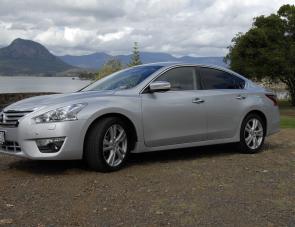
The new Altima features sweeping modern lines.
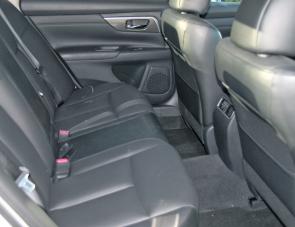
Comfort in the Altima’s rear seat is ensured thanks to ample leg and head room plus leather trim.

Many of the Altima’s steering wheel controls are visible in this image including the shifter paddles.
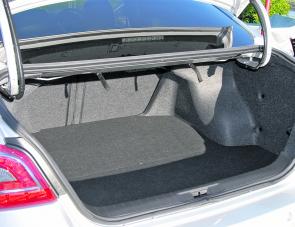
The Altima’s luggage capacity can be enhancing by folding rears seats down as well if necessary.

A look at the Altima’s dash layout: there’s a neat blend of tonings with all controls easily identified.
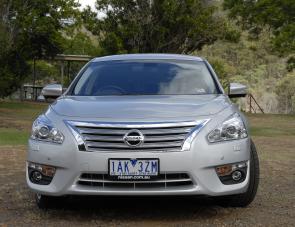
That impressive frontal treatment gives the Altima a certain road presence.
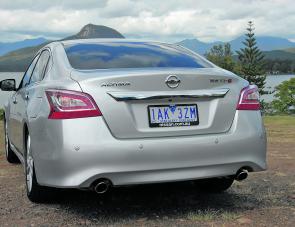
The Altima’s upswept rear end and twin exhausts hint of performance.




